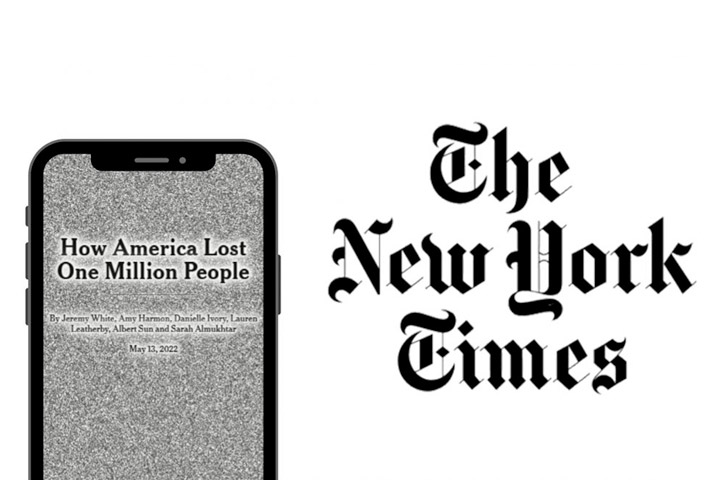In the age of information overload… not all content is created equal. Some content is there specifically to enhance your media’s reputation: so pump up that prestige factor!
The interactive content of the New York Times is one of the most appreciated, commented and read formats. But where does it fit in the Old Grey Lady’s content strategy?
I studied a sample of several thousand articles posted on Twitter and Facebook in 2022, both on the war in Ukraine and the Covid crisis, to better understand their keys to success on social networks and therefore how they contribute to the prestige of the New York Times.

Memorable content
What best characterises the NYT’s famous interactive content? What draws in the readers? After a punchy title, readers discover, for free, a concise presentation of complex situations in a well-written format of explanatory content with equally well-designed, innovative and eye-catching graphics. The content is perfectly adapted to mobile phones thanks to scrollytelling.
Before starting to design these visualisations, you must first refocus the problem at scale that begins with setting a clear goal. The reader must have all the insights needed to understand complex situations, whether it is a pandemic, a war, or the crisis facing biodiversity.This interactive content transforms the raw digital data into an engaging format for the reader.
The NYT doesn’t just represent its data as simple graphs; it brings it to life as maps, animations: a entirely new medium.
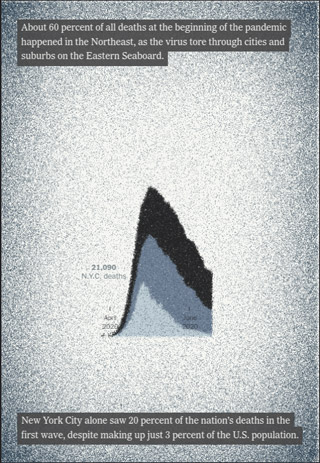
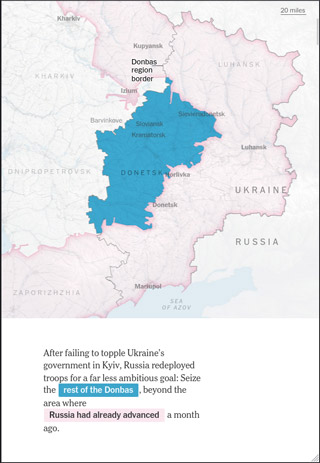
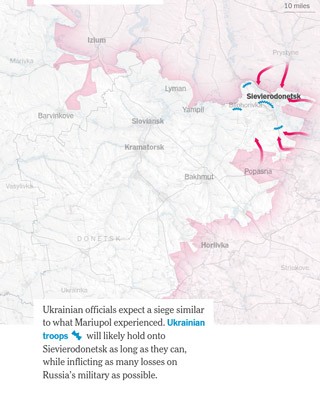
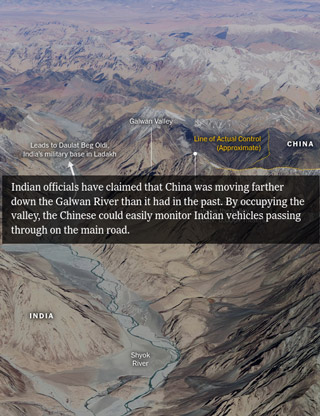
To build these visual storiesyou must be familiar with the full range of resources available, both human and software. That means knowing the full potential of, for example, Google Earth visualisations, or engaging graphic designers to make more attractive maps. You also have to be prepared to create something beautiful simply for the sake of the beauty itself, because that is part of the appeal, the visual seduction that catches your readers’ eye and draws them into your narrative.
Shorter headlines to make a point
The first distinguishing feature of this interactive content is the headline: short, and to the point, as you will see in the interactive graph below. Compared to other headlines published by the NYT or articles published by other media, the trend is confirmed in a sample of 10,000 articles on the war in Ukraine: the NYT’s interactive headlines have a median length 50% shorter than traditional articles in the same newspaper and 2 times shorter than those of other media.
Legend. I extracted 10,000 articles published between January and July 2022 and dealing with the war in Ukraine. I analyzed this sample of contents (see graph above) according to the length of their titles and I grouped them in three families: the interactive contents of the NYT (in green), the standard contents of the NYT (in red) and the contents published by all other media (in blue).
Free, high-performance content
My next step was to extract a new sample of 10,000 articles, published between January and July 2022, dealing with Covid to better appreciate the impact they had on Twitter and Facebook (see the chart below). The result? The NYT’s interactive content is consistently placed at the top of the list. As you will see in the graph below, the NYT’s interactive content has a median number of shares that is much higher than the NYT’s standard content, and of course than that of other media. Note that in this sample of 10,000 articles, there are only two NYT interactive contents, but they are in the top 5 most shared articles on Twitter. In short, these are exceptionally high-performing articles, designed to attract new users and reach far beyond the traditional readership.
This graph is interactive. By hovering your cursor over the shapes, you will see the title of the article being studied.
The trick with interactive content is explanatory articles prove every bit as popular in sharing terms as breaking news.
By producing timely content in an original format with great graphic investment, the NYT stimulates both its existing community by offering an innovative format, and a promise of new content, as well as new consumers who will associate their first contact with the brand with this engaging experience.
Beyond these considerations, free, quality content is a testament to your dedication to your mission and a means of testing new formats and workflows that can potentially be incorporated into more traditional productions. In short, articles dedicated to increasing the prestige of the NYT are read by an audience that goes well beyond the NYT’s readership.
So, free, quality content through which you can test new formats provides a perfect platform to innovate, while seeking to improve your work processes. Both of which are essential assets when it comes to preparing your future. Indeed, you will be able to integrate the new advances into your more traditional content production and you will have a concrete way to increase the reputation of your media with new audiences.
Manage your editorial mix
All content is not equal… A media outlet, whatever it is, must produce both content in the quantity required to dominate the space it wishes to occupy, but also content of higher quality to better engage and justify a price tag. The New York Times has understood the role, and importance, of prestige content production. The share of this content is limited but relatively stable across the subjects studied. In fact our sample shows that only 2 to 3% of the articles in the NYT output can be classified as being primarily aimed at boosting the prestige of the NYT brand (see the chart below).
And now it’s your turn!
As you will have understood, there is no question of reproducing this type of interactive content as is. Few of us have the luxury of the NYT’s resources and deep pockets. But we can all ask ourselves certain questions to find that winning formula.
- Are you clear about your editorial mix? How do you want it to evolve to meet your objectives in the years to come?
- Do you discuss the objectives of your content sufficiently within your editorial team?
- Do you have the variety of skills within your editorial team to imagine and develop YOUR format in a way that will enable you to increase your reputation?
- Do you know the attributes of success for your content? In particular, what are the keys to a good headline, or what themes perform strongly compared to your competitors?
- Do you have enough in-house skills to process the data and design the most attractive visualisations possible? Only by applying them, and maximising their impact, can you introduce a process of continuous improvement.
At your scale, with your resources and bearing in mind your technical constraints, you should still be able upgrade your editorial mix by thoughtful questioning of content goals: engagement, Premium or Reputation!
Ultimately, your community will judge you by the quality of this more eye-catching content, while new users will hold your brand in higher esteem because of the seductiveness of this, their first encounter.
In short: Even a small amount of quality, polished and free content will put a sheen on your editorial mix and boost your prestige. This means a win-win situation for your image, hand in hand with the enhancement of your skills, and potential for future improvement.
